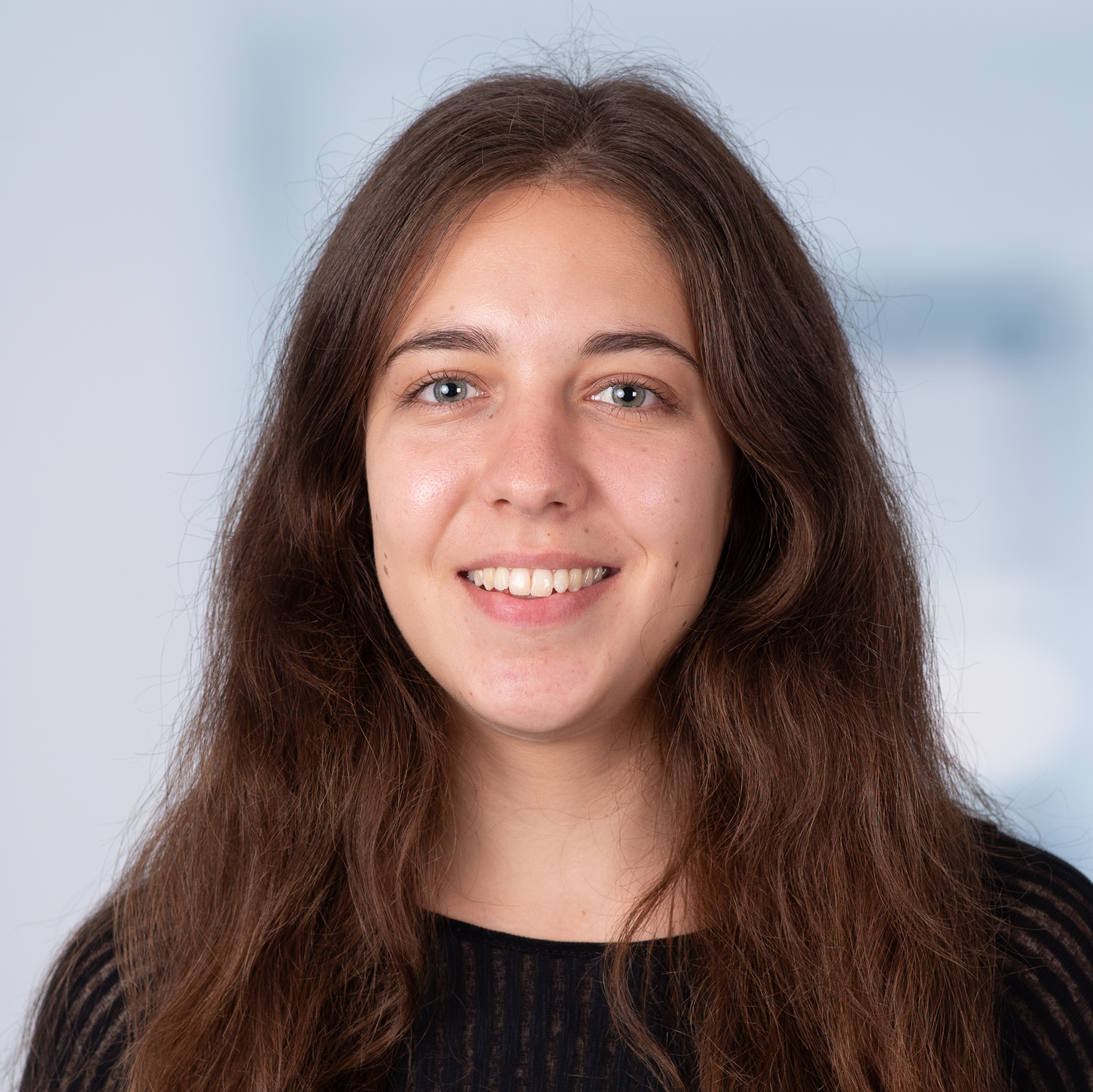


Title: The role of muscularis macrophages in mediating local immune responses in a mouse model of multiple sclerosis
PhD student: Alicia Weier
Multiple sclerosis (MS) is an autoimmune disease of the central nervous system (CNS) affecting more than two million people worldwide. The exact pathomechanisms have remained unclear and the disease is not curable to date. The histopathology of MS is characterized by inflammation, demyelination and axonal damage. Patients typically present with a wide and heterogeneous range of symptoms depending on the lesion localization, including visual, sensory, motor and cognitive deficits. Interestingly, about two thirds of patients also show gastrointestinal dysfunction, frequently even before the onset of CNS symptoms. We have previously demonstrated the degeneration of the enteric nervous system (ENS) in experimental autoimmune encephalomyelitis (EAE), which is the most common mouse model of MS. Besides the ENS the gut wall also contains several populations of immune cells, among them are the so-called muscularis macrophages that may play an important role in mediating local immune responses. It was recently shown that this population has anti-inflammatory properties and our initial data suggest that these macrophages express casein. So far, there are no studies that further elucidate the role of muscularis macrophages in the context of MS and in relation to ENS pathology. The aim of this project is to perform an in-depth immunological characterization of casein-expressing muscularis macrophages and to identify their functional role in the generation of local immune responses. To this end, a wide range of clinical-physiological, molecular and histological methods will be employed. Using established protocols of the Kürten lab in Bonn, we will induce EAE in wild-type and casein-deficient mice to analyze the function of muscularis macrophages in this particular neuroinflammatory environment compared to homeostasis. With results obtained during the first year in Bonn, we will use the expertise of the Furness lab in Melbourne to investigate ENS function both on the clinical and physiological level in casein-deficient healthy and EAE mice, which will be complemented by histological measurements performed in Bonn.



Title: Identification and characterization of intracellular host proteins with broad-spectrum antiviral activity against human viruses
PhD student:Yongyan Xia
Human pathogenic viruses present an ongoing global public health problem highlighted by continuing endemic infections and seasonal epidemics, as well as pandemics caused by newly emerging viruses. While host proteins play specific roles in normal cellular function, some of these proteins also display antiviral activity, and are termed host restriction factors. Host restriction factors can inhibit the infection and replication of different viruses at distinct stages in the viral life cycle. In general, the expression of host restriction factors during viral infection occurs following sensing of common pathogenic components via pattern recognition receptors (PRRs) and the production of type I interferons (IFNs). IFNs, in turn, activate hundreds of interferon-stimulated genes (ISGs) resulting in the inhibition of specific viruses, and some ISGs display a broad antiviral activity. SAM domain and HD domain-containing protein 1 (SAMHD1) is an intracellular dNTP triphosphohydrolase (dNTPase), while membrane-associated RING-CH-type finger protein 8 (MARCH8) is a family member of the RING-type E3 ubiquitin ligases expressed on the cell surface. This project studies molecular pathways to understand how intracellular host factors, SAMHD1 and MARCH8, restrict the infection and replication of different RNA and DNA viruses. Research in the Reading Laboratory in Melbourne focuses on the ability of these host factors to mediate direct antiviral activity against a range of human RNA and DNA viruses, including influenza A virus, respiratory syncytial virus, herpes simplex virus and vaccinia virus. Research in the Bartok Laboratory in Bonn focuses on the ability of SAMHD1 and MARCH8 to mediate indirect antiviral activity through the modulation of type I IFN signalling and ISG induction. Overall, this project aims to identify and characterise host restriction factors with novel antiviral activity against one or more human viruses, which might represent targets for the development of broad-acting antiviral therapies in the future.


Title: Role of Melanoma Phenotype on Immune-cell Crosstalk and Immune Surveillance in Lymph Node Metastasis
PhD student: Farah AbdelAziz
Malignant melanoma is an aggressive type of skin cancer that has the ability to metastasize to surrounding organs, rendering standard therapies ineffective. The emergence of tumor escape mechanisms in response to the microenvironment allows for tumor plasticity and tumor resistance causing limitations to treatment options. One such mechanism is phenotype switching where melanoma cells could switch between a differentiated and a de-differentiated phenotype, thereby altering the expression of specific melanocytic differentiating markers and escaping immune surveillance. Using Hölzel’s expertise in molecular and tumor biology, a B16 melanoma model would be generated featuring different phenotypic characteristics to study the effect of these phenotypic differences on immune cell phenotype via in-vitro and in-vivo approaches. Once validated, the model could be studied in-vivo to track tumor development and metastasis to the lymph node via an epicutaneous model generated in Gebhardt’s lab using different complex imaging techniques. This would allow us to study the interaction between the immune cells and melanoma cells in-vivo. In addition, it would be of interest to study human primary melanoma models by analyzing lymph node sentinels containing primary tumor lesions and analyzing their phenotype in parallel with immune cells to examine the spatial interaction, heterogeneity, and frequency at a single level using a highly multiplexed imaging technique to characterize multiple markers at the same time. Thus, by deciphering the role of melanoma phenotype on immune cell surveillance and metastasis, a better understanding could be achieved in characterizing the cell dynamics, the tumor microenvironment, therapy resistance mechanisms, and biomarkers involved in the immune-mediated control of melanoma.


Title: Interrogating cancer-immune crosstalk in metastatic melanoma
PhD student: Rebecca Bartholomeusz
Metastatic disease is the major cause for cancer-related mortality. Metastatic spread and outgrowth are accompanied by dynamic changes in the interactions between cancer and immune cells with key aspects of this crosstalk likely to depend on disease stage and the type of organ affected. The Gebhardt laboratory has recently developed a preclinical melanoma model that allows to study immune control of metastatic melanoma following curative-intent surgery of primary tumours. As part of previous joined PhD projects, the Hölzel laboratory has generated and contributed numerous genetically modified melanoma lines to the model. These cell lines are now routinely used in the Gebhardt laboratory and have been integral in generating the preliminary data that the aims of the PhD project are now following up on. More specifically, the project will investigate the functional significance of melanoma cell expression of MHC II in lymphoid metastases. In addition, the project will seek to be better understand how immune pressure impacts on the route of metastatic dissemination from primary tumours, as well as on the clonal composition of metastatic deposits in different organs. Work with the in vivo model will be conducted in the Gebhardt laboratory where all required methodologies are already established (e.g. high dimensional flow cytometry, multiphoton and bioluminescence imaging, histology). Generation of new melanoma lines and high dimensional imaging of samples shipped from Melbourne will be conducted in the Hölzel where these techniques are used routinely.



Title: Understanding how the microbiome shapes immunity
PhD student: Michael Wilson
The symbiotic interactions between a host and its associated microbiome are pivotal in many physiological processes, particularly in the development and maintenance of immune cells.
Evidence from the Bedoui laboratory points towards microbiome-derived signals driving at least some parts of these host-microbiome interaction. Butyrate, a metabolite derived from the gut microbiome was shown to direct CD8 “killer” T cells to a more memory like phenotype. However, the nature of these metabolites and their underlying mechanisms by which they influence CD8 T cells remain relatively uncharacterised. Additionally, other forms of microbiota-immune cell interactions are likely to influence the phenotype of CD8 T cells. In this project, these mechanisms will be investigated utilising various techniques such as the multiplex imaging expertise of Michael Hölzel, high dimensional flow cytometry, and 16S rRNA sequencing for microbiota characterisation. Furthermore, these mechanisms will be examined in various disease contexts with the aim of discovering molecular pathways that can be targeted to reduce overall disease burden.



Title: Impact of chromatin remodelers on COVID-19 induced re-programming of peripheral monocytes
PhD student: Carolyn Krause
Scientists around the world have been working intensively to elucidate potential pathophysiological mechanisms, prognostic inflammatory markers, and potential therapeutic targets in SARS-CoV-2 infections since its outbreak in late 2019. Our research is currently focused on monocytes, which migrate from the circulating blood into the infected tissues during viral or bacterial infection and differentiate into antigen-presenting cells (APCs) according to the inflammatory milieu. As central mediators of immune responses, APCs are central for the uptake of cellular debris from infected cells as well as for phagocytosis and presentation of antigens to T cells via the MHC class II molecules. Together with Zeinab Abdullah’s group, and other collaborators of the IRTG, we observed a loss of expression of MHC class II molecules (e.g. HLA-DR) on monocytes from COVID-19 patients, particularly in severe courses. The underlying mechanism leading to this suppression is not yet fully understood and is part of our current investigation.
We are using transcriptomic and epigenetic next-generation sequencing approaches to understand changes in the expression of genes involved in the antiviral immune defence mechanisms of myeloid cells. This project aims to (1) elucidate epigenetic mechanisms contributing to the decreased expression of genes participating in antigen presentation of peripheral monocytes, (2) investigate the role of chromatin remodelers in SARS-CoV-2 infection, which may (3) explain the functional dysregulation of monocytes in severe COVID-19 patients leading to disease progression.
The Bonn-based project is headed by Susanne V. Schmidt (Group leader of the Immunogenomics Group at the Institute of Innate Immunity, University Hospital Bonn). The group's preliminary work contributed to several studies focusing on novel methods to detect SARS-CoV-2 in body fluids and the role of IFNα in NK cell dysfunction in severe COVID-19 cases. Since 2018, we have collaborated extensively with Sammy Bedoui (Peter Doherty Institute, University of Melbourne), who is an expert in the interplay of innate and adaptive immunity in viral infections. Together with Sammy Bedoui’s group, we will be able to verify and investigate dysfunctional signalling pathways in COVID-19 patients with severe progression and identify potential markers in mouse models with different COVID-19 disease courses.



Title: Identification of Common Gene Signatures in CNS T cells
PhD student: Aleksej Frolov
In the last decade, the immunology field experienced a significant paradigm shift towards a better understanding of immunologically privileged sites. Looking at the Central Nervous System (CNS) for example, scientists in the mid-twentieth century believed this tissue to be segregated from any immune cell. This believe was founded through experiments showing the absence of graft rejections in the CNS and the presence of the blood-brain barrier. Now we know, that a plethora of immune cells reside and migrate in and around the CNS. These cells perform vital functions in homeostasis as well as disease.
One of such cell types are T cells, which were shown to invade and reside in the brain meninges and parenchyma at a steady state. Furthermore, higher numbers of Tregs and CD8+ T cells were observed in various mouse models of neurodegeneration and patient data.
With Beyer’s group (Bonn, Germany) expertise in T cell biology and high throughput single cell technologies, we aim to characterize common T cell signatures in the CNS and compare them across multiple modalities, health status, and species.
The work in Beyer’s group will be the basis for downstream molecular biology and in vivo experiments with the aim to characterize single significantly altered pathways in more detail. Kallies’ group (Melbourne, Australia) long term experience and profound knowledge of T cell residency and the impact of transcriptional factors will be vital in the second part of this project.


Title: The function of the NLRP10 inflammasome in skin immune homeostasis
PhD student: Matilde Bartolomei Viegas de Vasconcelos
The skin is our largest organ and protects the body’s surface from microbial and environmental threats. The outermost layer of the skin, the epidermis, mainly consists of keratinocytes in defined stages of differentiation. These cells are central to skin immunity, as they can mount cell-autonomous immune responses and shape the behavior of skin-resident immune cells. Depending on their differentiation state, keratinocytes express selected innate immune receptors, such as the NOD-like receptor family members NLRP1 and NLRP10. Upon sensing pathogens or cellular stress, these receptors initiate signaling cascades, leading to the release of potent pro- and anti-inflammatory IL-1 family cytokines.
The Latz laboratory has recently shown how NLRP10 senses mitochondrial damage and consequently forms a canonical inflammasome. Via RNAscope staining in human skin, endogenous NLRP10 expression was found selectively in terminally differentiated keratinocytes in the stratum granulosum. Analysis of immune sensors and inflammasome effector molecules from single cell data of normal human skin showed that the NLRP10-positive keratinocytes also had high expression of anti-inflammatory members of the IL-1 cytokine family, such as IL-37 and IL-38, and of a particular gasdermin (GSDMA). Moreover, loss-of-function mutations in NLRP10, or SNPs associated with low expression of NLRP10, are associated with atopic dermatitis, suggesting that NLRP10 can negatively regulate skin inflammation. Our hypothesis is thus that NLRP10 could engage a novel form of programmed anti-inflammatory cell death in keratinocytes during the physiological cell demise in the cornification process.
In this collaborative project, we want to continue the NLRP10 investigations under two aspects. On the one hand, using the inflammasome expertise of the Latz laboratory, we will carry on with the NLRP10 mechanism studies. There are still some open questions regarding the upstream mechanism, like potential endogenous triggers of NLRP10 and its specific mitochondrial ligand, as well as the downstream inflammasome effects, such as the release of pro- or anti-inflammatory cytokines. On the other hand, we will profit from the Bedoui laboratory skin expertise, to investigate the more physiological role of NLRP10 in the skin homeostasis and pathology. In conclusion, the two laboratories are a perfect fit to investigate the role of this new inflammasome in the skin.



Title: Identifying novel targets and pathways involved in immune escape
PhD student: Fenna Floortje Feenstra
Cancer immunotherapies have revolutionized the treatment for many cancer patients. Despite the great success, a considerable group of patients do not respond or acquire resistance to currently approved cancer immunotherapies. Therefore, there is an unmet need to discover novel targets and pathways to improve the survival of cancer patients. Immune escape via upregulation of inhibitory molecules in the tumor microenvironment (TME) gained a lot of interest over the past years. This has led to the development of immune inhibitors such as PD-1/L1. On the contrary, little is known about the regulation of immune activating receptors in the TME. The Bald lab (Bonn, Germany) showed that CD155-expressing tumor cells induced internalization and degradation of the CD226, which rendered T-cells dysfunctional and contributed to resistance to cancer immunotherapy. Thus, the loss of CD226 represents a novel immune escape mechanism in addition to the upregulation of T-cell inhibitory receptors in tumor-infiltrating T-cells. To date, little is known about the importance of CD155-CD226 interaction between T-cells and cancer cells. Our central aim is to further advance our knowledge on the role of CD155 on APCs and tumor cells for the interaction with T-cells. The Noble Prize awarded CRISPR gene editing technology is a useful tool to study intrinsic cellular mechanism. By using genome-wide CRISPR/Cas9 screens (expertise Prof. Marco Herold in Melbourne, Australia) my research project aims to better understand the regulation of CD155 and CD226 to find new therapeutic targets and improve immunotherapies.


Title: Investigating the role of cMaf and in CD8 T cell function and differentiation in response to chronic infection
PhD student: Anh Nhat Truong Huynh
CD8 T cells acquire a unique epigenetic and functional profile, termed T cell exhaustion, in response to chronic stimulation. Precursor of exhausted CD8 T cells (Tpex) are known for their differentiation and self-renewal capacity, thus play important roles in antiviral and antitumor response. In addition, T cell exhaustion is orchestrated by several transcription factor. Previous studies have showed c-Maf, regulated by the Maf (musculoaponeurotic fibrosarcoma) gene, is the major driver of exhaustion in many CD4 T cells and tumour-responsive CD8 T cells. In this collaborative project between Utzschneider lab (Melbourne) and Kurts lab (Bonn), we aims to investigate the role of transcription factor c-Maf in CD8 T cell differentiation and function in response to chronic infection.



Title: Impact of the chemokines CCL17 and CCL22 on the development of infectious immunoparalysis
PhD student: Laura Bahr
Sepsis is a life-threating disease, which is associated with 20 % of the world’s deaths. In 2017, the WHO demanded the initiation of national measures to avoid sepsis and to improve diagnoses and therapies (Fleischmann-Struzek et al. 2022). Viral, bacterial or fungal infections like pneumonia under the condition of a dysregulated immune response can lead to sepsis. This appears as an early hyperinflammatory response to a pathogen with potential organ-failure. After this inflammation phase, the immune system often is suppressed in the longer run, even after recovery from the primary infection. The patients are then more susceptible and less immunologically equipped for a secondary infection (Hotchkiss et al. 2013). The understanding of the molecular mechanisms that lead to such a suppression, would provide new treatment strategies for sepsis-patients, as they could focus on the resurrection of the patient’s immune system. It is therefore necessary to break down this immunoparalysis with standardized models. However, immunoparalysis is a heterogenous condition with many phenotypes. Most strikingly, the innate antigen-presenting cells (APC) monocytes and macrophages showed decreased release of proinflammatory but not anti-inflammatory cytokines. Also, dendritic cells (DCs) were shown to even increase anti-inflammatory cytokines such as IL-10 (Bruse et al. 2019). Further, the chemotaxis is impaired during immunoparalysis, too. Here, it was shown that in human lethal sepsis cases, there was an increased level of chemokines of the CCL-family (Vermont et al. 2006). This indicates, that chemokines participate in the development of sepsis and immune suppression. The chemokines CCL17 and CCL22 are barely studied in sepsis and sepsis-induced immunoparalysis. However, CCL17 recruits CD4+ and regulatory T-cells (Treg) and steers the activation and migration of DCs (Weber et al. 2011). CCL22 is important for the interaction of DCs with Treg and is associated with immune escape in tumors. In lungs it is highly expressed, where it was already proven to influence diseases like asthma (Rapp et al. 2019). CCL17/22 both share the common receptor CCR4, which is also involved in immune suppression after sepsis (Molinaro et al. 2015).
The project aim is to clarify the „Impact of the chemokines CCL17 and CCL22 on the development of infectious immunoparalysis “. The first 3-6 months of the PhD project will be held in Bonn for experiments on uninfected mice. Here, CCL17/CCL22-expressing cells of the lung and their functionalities will be identified. Bonn-based methodologies allow the use of gene-targeted mouse-models for chemokine research (CCL17/EGFP reporter/knockout mice) and the isolation of lung immune cells in cooperation with N.Garbi, fluorescence-activated cell sorting, histology and confocal microscopy, and RT-PCR. Following this, the PhD will be held in Melbourne until year 1,5. Here, the Villadangos murine model of E.coli-induced pneumonia will be conducted in their infection facilities. The partner’s laboratory further allows to learn suitable read-out assays for APC function. Dependent on ongoing experiments by Manja Thiem (current IRTG PhD-student), a CRISPR-screen for the gene encoding of a potential second receptor for CCL22 can be performed. In this regard, the PhD project further profits from the strong expertise of J. Villadangos in proteomics. After one year, the project will be continued in Bonn. At this point, the model acquired in Melbourne will be implemented in the local facilities to assess the role of CCL17/22 on infected CCL17/22 or CCR4KO mice and subsequent analysis of immunoparalysis. Aptamer inhibitors, as well as metabolic parameters of WT and KO lung immune cells will be tested. The project thus contributes to the basic research in the field of immunology and infectiology.


Title: Identification of Legionella pneumophila factors modulating the immune response
PhD student: Alexandra Mary Brodmann
Legionellosis or Legionnaires' Disease is a severe form of communicable pneumonia caused by Legionella pneumophila. This pathogen can hijack lung macrophage biology to create a specialised vacuole in which it can replicate, serving as a platform from where it can establish infection leading to lung failure and sepsis. Efficient control of Legionella infection requires the contribution of a network of innate pattern recognition receptors, cytokine signalling, and infiltration of myeloid and lymphoid cells, especially neutrophils and monocyte-derived cells.
Although much is known about Legionella’s type IV secretion system used by Legionella to inject effectors subverting macrophage biology, little is known about the mechanisms used by this bacterium to dampen the recognition and immune response allowing replication and immune escape.
Combining the expertise of the laboratories of Prof. Elisabeth Hartland (University of Monash, Australia), Prof. Ian van Driel (University of Melbourne, Australia) and Prof. Natalio Garbi (University of Bonn), the overarching goal of the project is to identify L.pneumophila mechanisms interfering with recognition by macrophages resulting in immune escape. For this, unbiased genetic screens of L. pneumophila for their ability to replicate in human and mouse macrophages will be performed. Once mutants are identified for their ability to subvert macrophage defense, we will delineate the responsible mechanisms using a multi-omics approach consisting of transcriptomics, phosphoproteomics, metabolomics, and lipidomics. Finally, we will employ our in vivo pre-clinical mouse model of infection to investigate the immune response to those mutants and the possibility to interfere with the resulting escape mechanisms to identify novel therapeutic targets.



Title: Discovery of novel mRNA-modifying enzymes in Legionella pneumophila
PhD student: Joshua von Ameln
Legionella pneumophila is an intracellular bacterial pathogen and the causative agent of Legionnaire’s Disease. To survive and replicate intracellularly, Legionella uses a type-IVb secretion system to inject over 330 virulence factors into the host cell. Many effector proteins are enzymes that mediate post-translational modifications of host proteins; however, effector proteins which modify host mRNA have remained unknown. The overall aim of this project is to use RNA-interactome capture (RIC) methods to isolate novel Legionella enzymes that bind mRNA during infection and to investigate how they regulate the host epitranscriptome and host defence. In the first two years, the expertise of Kitty McCaffrey, Elizabeth Hartland and Ian van Driel will be utilised to identify and characterise mRNA-modifying effector proteins in vitro using RIC methods, high-throughput proteomics as well as structural analyses. Furthermore, enzymatic activity will be investigated in vitro using knock-out Legionella strains and “enzyme-dead” protein mutants. In the final year, the expertise of Natalio Garbi with the Mus musculus model system will allow us to further investigate the identified enzymes in in vivo infection models. Combining the expertise, experience, and unique opportunities that both institutions offer will allow us to comprehensively identify and investigate mRNA-modifying enzymes in Legionella.



Title: Innate immune responses during productive and non-productive Influenza infections
PhD student: Linda Kurth (née Schwarzenberg)
Professional antigen presenting cells like monocytes and macrophages are at the interface of the innate and the adaptive immune system and therefore are crucial to induce effective antiviral immune responses. Monocytes recognize invading viruses by detecting viral RNA or DNA by endosomal toll-like receptors (TLR), cytosolic RIG-I like receptors (RLR) or cGAS. Activation of the nucleic acid receptors leads to the induction of a type I IFN dominated antiviral immune response. Besides constitutively expressed restriction factors, the course of a viral infection in monocytes depends also on the efficacy of this innate immune response. Influenza hemagglutinin is a critical determinant of the course of infection. However, its influence on innate immune signalling has not been addressed so far.
Using reverse genetics, the Londrigan group (Melbourne) established a cellular complementation model to find Influenza hemagglutinin (HA) derivates that mediate productive infection of the Influenza PR8 model strain in human monocytes that usually is only able to cause abortive infection. After identification of abortive and productive infectious HA derivates from human seasonal Influenza strains, an interactome approach identified host proteins bound to productive but not to abortive HA derivates. Unexpectedly, also cytosolic proteins were among interacting proteins, suggesting an impact of HA on cytosolic proteins.
In the PhD thesis we aim at characterizing the interaction of HA and other viral proteins of more or less pathogenic Influenza strains with host factors involved in signalling downstream of endosomal and cytosolic nucleic acid receptors. As a first step, the PhD student will establish a screening tool involving the monocytic cell line THP-1 which expresses most known innate immune receptors and is easily genetically modified using CRISPR-Cas9 technique in our lab. Here, a transient transfection protocol has to be established in cGAS deficient THP-1 cells that allows an easy and fast readout to screen the impact of viral proteins expressed from plasmids on innate immune pathways. For establishment of the assay, an NS1 protein (well established INFLUENZA antagonist of RLH signalling) will be used to titrate IFN reporter plasmids and RIG-I stimulus in co-transfection experiments.
After screening and identification of viral proteins impairing host signalling (RLR, cGAS, TLR7,8), pull-down assays with candidate viral proteins followed by mass spectrometry or Western blot will identify interacting host proteins. Knock-out of host proteins and mutational analysis of the viral protein will further exhibit the mechanism and interaction site of the viral proteins' action.
In Bonn, the effect of viral proteins expressed in THP1 cells and knock-down of interactors on signalling will be analysed. In Melbourne, the found effects will be confirmed using whole viruses.



Title: Aging-associated immune response to infection
PhD student: Sophie Müller
The percentage of the population older than 65 years is constantly growing. This age group is often more susceptible to infections and has a more severe disease course. Therefore, the prevention of infection by vaccination is crucial. However, the vaccine immunogenicity and efficacy is lower for the elderly. For the formation of protective immunity and long-lasting immune memory, the activation of the innate and adaptive immune system is required. We hypothesize that the heterogeneity of the immune response increases in elderly adults and correlates with clinical phenotypes such as a higher susceptibility to infection. For this project, we will combine the expertise of the Bedoui group on the interaction of innate and adaptive immunity during infection and the Aschenbrenner group on clinical single cell genomics. We aim to investigate the heterogeneity of the immune response to vaccines in elderly adults by analysing the blood immune cell compartment on single cell level applying single cell RNA-sequencing and flow cytometry. We will identify transcriptional signatures and immune cell phenotypes, which correlate with the vaccination success.
Using an ex vivo whole blood stimulation approach with vaccine antigens, we will mimic the initial phase of the vaccine response and aim to predict the vaccination outcome. Finally, we will develop a genetic mouse model to study the molecular mechanisms of the aging-related immunological defects in vivo.

Title: Molecular mechanisms of antiviral NLRP1 responses in different skin model
PhD student: Dorothee Johanna Lapp
Innate immunity prevents the establishment or progression of infections by reducing or eliminating pathogens. To maintain health, the presence of pathogens and the associated infection have to be sensed and an efficient response has to be induced. Inflammasomes are cytosolic multiprotein signaling complexes which assemble upon activation and regulate inflammation in a caspase (CASP)-1 dependent manner. NLRP1 is the only inflammasome sensor expressed in keratinocytes of the skin but it is also expressed in other cell types including T cells, neurons, enteroendocrine cells in the intestinal epithelium, as well as monocytes. NLRP1 is activated by diverse stress signals, and nucleates inflammasomes by polymerizing the adaptor protein ASCleading to caspase-1 activation and the maturation and release of pro-inflammatory cytokines.
In a recent project, we discovered that NLRP1 in keratinocytes can be activated by direct phosphorylation by MAP kinase p38, which is initiated by different triggers of the ribotoxic stress response as well as by infection with alphaviruses. It is likely that phosphorylation of NLRP1 is the signal for ubiquitination and N-terminal degradation of NLRP1, which seems to be critical for inflammasome assembly.
In this thesis, we aim to dissect p38-dependent molecular mechanism of NLRP1 activation by arthropod-borne RNA viruses, including Semiliki Forrest or Chikungunya virus. To this end, we will apply pooled CRISPR/Cas9 screens to identify the crucial ubiquitin ligase machinery for p38-dependent NLRP1 activation as well as potential additional MAP3 kinases upstream of p38.
Furthermore, the physiological role of alphavirus-induced NLRP1 activation will be characterized in different human skin models. We are eager to examine how NLRP1 activation and the ensuing inflammation is coordinated between the different cell types of intact primary skin.


Title: Development of therapeutics to prevent norovirus disease
PhD student: Thalia Frota
Norovirus is an insidious virus that causes around 700 million infections and 200,000 deaths each year, at the approximate cost of $USD 60 billion to the health care sector. The virus strikes at the most vulnerable groups including aged care facilities, hospital wards and in childcare settings with the immunocompromised an additional highly susceptible community. Surprisingly though, there is no current prevention nor antiviral therapies against this highly infectious disease. The hindrance to these developments is the inability to effectively cultivate the virus in the laboratory and the absence of a small animal model of infection. In this research project, build upon a collaborative effort between Prof Mackenzie (Melbourne) and Dr Schmidt (Bonn), we aim to establish norovirus infection model using intestinal organoids derived from clinical samples and to determine the design and application of norovirus virus-like particles and norovirus-specific nanobodies as preventative and therapeutic applications. We will generate relevant circulating human noroviruses directly from clinical samples and infect these viruses onto intestinal organoids. Our major aim here is to establish infection models with human norovirus to assess the impact of infection on cellular responses particularly immune activation and cell death. Using this system, we can also compare symptomatic viruses with viruses known to be asymptomatic and identify key genetic determinants of pathogenicity. Furthermore, we will also construct and produce immunologically relevant norovirus virus-like particles as vaccine candidates and as reagents to generate norovirus specific nanobodies by immunizing alpacas or llamas at the University of Bonn. We will be able to conduct lentivirus screens to identify neutralizing nanobodies. The identified norovirus-specific nanobodies will subsequently be delivered into the gut, the site of norovirus replication, to test the therapeutic applications in mice and humans.



Title: The influence of maternal immune activation and high Heme levels induced by malaria infection on fetal microglia and neurodevelopment
PhD student: Daria Joanna Hirschmann
Recently gathered evidence links the susceptibility and severity of several diseases emerging throughout life not only to genetic predisposition and environmental triggers but also to in utero or early-life perturbations. Maternal inflammation and placental inflammation are now recognized as risk factors for the onset of psychiatric or neurological disorders such as autism spectrum disorders. During malaria infection, the placenta can become heavily inflamed, a phenomenon termed placental malaria. Further, the increase of pro-inflammatory and toxic hemoglobin metabolites, such as free heme released from rupturing infected erythrocytes, perturbs fetal development. On the cellular level, macrophages are the major scavengers for dead and dying erythrocytes and are involved in hemoglobin metabolism.
Macrophages are long-lived cells that originate from erythro-myeloid progenitors emerging from the yolk sac. In the brain, microglia are the main tissue-resident macrophage population, which are involved in synapse formation, the balance of neuronal survival and death, and clearance of neuronal remnants. Impairment of these processes is known to occur in many psychiatric and neurological disorders. Therefore, the in utero perturbation or differential programming of microglia can lead to changes in neurodevelopment, impacting the individual's susceptibility to psychiatric or neurological disorders. The Mass laboratory has investigated the effect of chronic maternal inflammation on tissue-resident macrophages and the Heath laboratory has extensively worked with mouse models of malaria and the impact of malaria infection on the immune system. Combining their expertise, we will set up a mouse model for maternal malaria infection and investigate its impact on the neurodevelopment of the offspring focusing on microglial changes. For this purpose, we will conduct histological analysis, cytokine measurements, (immune) cell phenotyping, immunofluorescence stainings, behavioral assessment, and transcriptome analysis. In addition, we will also use these methods to delineate the impact of increased hemoglobin metabolite concentrations on fetal neurodevelopment, as little is known about their impact on fetal development. Thereby, we will be able to better understand which maternal influences are critically affecting fetal neurodevelopment and identify the involved mechanisms.



Title: Immune Cell Migration in Tumour Microenvironments
PhD student: Stefanie Sagert
Cancer immunotherapy gained significant importance in recent years. Effective treatment depends on the successful infiltration of immune cells into tumor tissue. Uncovering mechanisms underlying “Cold” tumor environments with low lymphocyte infiltration and bypassing those to turn them into “hot” tumors with many infiltrated T cells can enhance immunotherapy remarkably. Huang et al. (2021) recently revealed that the upregulation of regulator of G protein signaling 1 (RGS1) reduces helper TH1 and cytotoxic T lymphocytes (CTL) trafficking into breast cancer and therefore dispel that the migration of immune cells into tumor tissue is only depended on chemokine receptor expression on the leukocyte surface. Knockdown of RGS1 improves tumor-specific CTL infiltration into breast and lung tumor grafts and inhibits tumor growth. Nevertheless, the details of the migratory behavior of T cell after RGS1 depletion have not been elucidated yet.
Thus, in this project we propose combining the expertise of the Kolanus lab on immune cell migration with that of the Mintern lab on cancer immunotherapy to further investigate T cell migratory behavior in the tumor microenvironment.
The accumulated knowledge about T cell trafficking into tumor tissue could be used in the future to further improve the effectiveness of cancer immunotherapy.



Title: Immunometabolism in endurance exercise and infection
PhD student: Laetitia Sanelli
Accumulating evidence suggests that exercise mediates beneficial effects on the functionality of immune responses. However, the detailed molecular and metabolic mechanises underlying these observations remain to be explored. Previously, our group set up an exercise model on the basis of voluntary wheel running. Using this model we found that endurance exercise results in a reduction of tissue infiltration by macrophages, monocytes and T cells in the context ofviral or bacterial infections. Notably, despite this reduction in cellularity the amount of cells producing cytokines remained unchanged. Hence, we will follow up on these findings and further investigate the changes induced by exercise in both bacterial and viral infections as well as expand our analysis to include models of allergy. With this project we aim to dissect both beneficial as well as potential adverse effects of exercise to expand our knowledge on how modern life style changes can influence the development of disease.


Title: Biochemical, structural and cellular characterization of NLRP1 inhibition
PhD student: Maria Zyulina
NLRP1 is a crucial protein involved in the formation of inflammasomes within the innate immune system. It is primarily expressed in keratinocytes and plays a significant role in inflammatory skin diseases. Gain-of-function mutations in NLRP1 have been associated with various skin disorders and autoinflammatory conditions. The protein undergoes self-cleavage at the C-terminus within the FIIND domain. This results in the activation of a C-terminal fragment that includes the CARD domain and a portion of the FIIND domain, while the remaining N-terminal fragment, consisting of the PYD, NACHT, and LRR domains, is believed to have an autoinhibitory function and is degraded upon inflammasome activation.
The NACHT domain of NLRP1 belongs to the STAND ATPases family, similar to the NACHT domains found in other NLRP proteins like NLRP3. Inhibiting NLRP1 activation could be a potential therapeutic strategy for treating autoinflammatory diseases associated with NLRP1overactivation. Currently, NLRP1 activation at the C-terminus is primarily regulated by the binding of Dipeptidyl Peptidases 8 and 9 (DPP8/9) to the C-terminal region of NLRP1.
Inhibition of DPP8/9 leads to the release of the C-terminal fragment, allowing for inflammasome formation.However, NLRP1 can also be activated at the N-terminus, although its role is currently understood mainly as an autoinhibitory function. Therefore, further investigation into inhibiting NLRP1 at the N-terminus is warranted to explore its potential therapeutic implications.
The inhibitor MCC950 targeting the NACHT domain of NLRP3 has been discovered, which effectively locks the protein in an inactive state. This inhibition not only stabilizes NLRP3 but also aids in its structural analysis using cryo-electron microscopy and crystallization. Given the structural similarity between the NACHT domains of NLRP3 and NLRP1, the search for a similar compound that can stabilize the NLRP1 NACHT domain is a promising avenue for future research.
In conclusion, targeting NLRP1 activation presents an opportunity for treating autoinflammatory diseases associated with NLRP1 overactivation. While the inhibition of DPP8/9 at the C-terminus has been extensively studied, the investigation of NLRP1 inhibition at the N-terminus remains an area that requires further exploration. Drawing from successful inhibition of NLRP3, the identification of a compound that can bind and stabilize the NLRP1
NACHT domain holds potential for advancing structural resolution and future therapeutic development.


Title: Investigation of a novel cell death protein
PhD student: Andreas Dumortier
Taking advantage of recent advances in the prediction of protein folds we have identified an uncharacterised protein that appears to be involved in cell death. This project will use unbiased approaches to determine the signalling pathways that the protein regulates and precisely how it may function to regulate cell death in contexts such as cancer, inflammation and infection. This could be related to programmed cell death such as apoptosis, necroptosis or the inflammasome and pyroptosis. Starting with studies in the Masters laboratory (Australia) we will make cell line models with CRISP deletion or overexpression of the protein and/or its relevant domains, and interrogate them using the world class medical research techniques available at WEHI. The project will then move for the final year of the PhD to the Geyer laboratory (Germany) for biophysical and structural studies of the heretofore uncharacterised protein. Through this work we expect to determine the cellular and biochemical role of the protein, which may provide opportunities for drug discovery and an improved understanding of fundamental biological process relevant to human disease.


Title: Revealing the regulatory T cell phenotype in the melanoma mouse model and its role in cancer immunity
PhD student: Di Wang
Regulatory T cells (Tregs) are a subset of T cells that exhibit high heterogeneity within different tissues. They can not only play an indispensable role in maintaining self-tolerance, but also have a negative impact on the anti-tumour immune reaction. Accumulating evidence revealed that depletion of Treg cells is able to enhance the anti-tumour immune response. Indeed, regulatory T cells can infiltrate into tumour tissues and modulate the activity of various cells in the TME, including T cells, B cells, NK cells, dendritic cells and various myeloid cells via humoral and cell-cell contact mechanism, which could hamper the immunosurveillance, facilitate the immune evasion and contribute to poor clinical outcomes.
In this project, we propose combining Prof. Kurts / Dr. Becker-Gotot`s expertise on melanoma mouse model with that of Prof. Vasanthakumar on regulatory T lymphocytes to study the roles of the regulatory T cells within the melanoma tumour microenvironment (TME) using the syngeneic B16-OVA melanoma mouse model. The aim of this project is to determine whether novel tumour (OVA)-specific Treg subtypes would be identified in the melanoma mouse model and whether each of them could possess unique genetic signatures and molecular markers. In addition, we will investigate the functions of the different Treg subpopulations within the TME and unravel how these Tregs exert their effects on tumour progression. Ultimately, we aim to clarify whether these specific molecules could serve as potential biomarkers in order to deplete tumour-specific Tregs and thereby improving immunotherapy against melanoma without destroying the peripheral tolerance at all.




Title: Role of G4-quadruplexes in acute myeloid leukaemia cells and myeloid antigen-presenting cells
PhD student: Alea Radcke
G-quadruplexes (G4s) are secondary structures abundant in DNA that regulate gene expression. DNA modifications, such as methylation of cytosine, could act as a dynamic switch by promoting or alleviating the structural formation and stability of G4s. There is a growing body of literature supporting the idea that methylation of G4 structures may be of fundamental importance to genome structure and function, playing an integral role in directing regulatory G4 formation in gene promoters and directing wider establishment of epigenetic marks. Demethylating substances are used for treatment in acute myeloid leukaemia (AML) and myelodysplastic syndrome (MDS) and improve the overall survival significantly. We hypothesize that methylated G4s act as a dynamic epigenetic switch, selectively activating or repressing gene expression in a cell specific and in addition to induce immune activation.
In this project, we propose combining Annkristin Heine’s clinical expertise on leukaemia treatment and myeloid cells with that of Katrin Paeschke on G-quadruplexes and Marco Herold on blood cancer and genome engineering. Colleagues recently showed that immature AML cells exhibit elevated levels of G4 structures in contrast to mature peripheral blood mononuclear cells in healthy individuals. In a collaborative effort between the Heine, Paeschke and Herold laboratories, we will clarify how methylation and demethylation influence G4 structure formation and stabilization in AML and myeloid antigen-presenting cells. In addition, the investigation of G4 ligands, which lead to G4 stabilization, may have an impact on the epigenetic status of several genes. We will test whether combination of demethylating agents with G4 ligands, as Pyridostatin, in AML and MDS treatment and antigen-presenting cells, influence the outcome of patient treatment or activation and differentiation of these immune cells.



Title: Dissecting the role of TGFβ in the induction and maintenance of T follicular helper cells in vivo
PhD student: Luisa Bach
CD4+ T cells play a central role in the immune system by orchestrating immune responses against a wide variety of pathogenic microorganisms. T follicular helper (Tfh) cells, the primary B cell helpers, express a unique combination of effector molecules such as the chemokine receptor CXCR5, the transcription factor Bcl6, costimulatory and co-inhibitory molecules (e.g. ICOS, PD-1), and secrete cytokines (e.g. IL-21, IL-4) to promote the activation, differentiation, and survival of B cells. Tfh cells undergo a multistep differentiation process in secondary lymphoid organs that involves sequential and cognate interactions with dendritic cells and B cells, ultimately leading to the generation of fully differentiated Tfh cells that reside in germinal centers. While the larger framework of the underlying processes is well established, it still remains unclear what signals besides antigenic stimulation induce and maintain Tfh cells. Here, we will dissect the molecular pathways and requirements for in vivo Tfh cell differentiation and in particular the contribution of TGFβ to early Tfh cell differentiation and to the maintenance of already established Tfh cells.